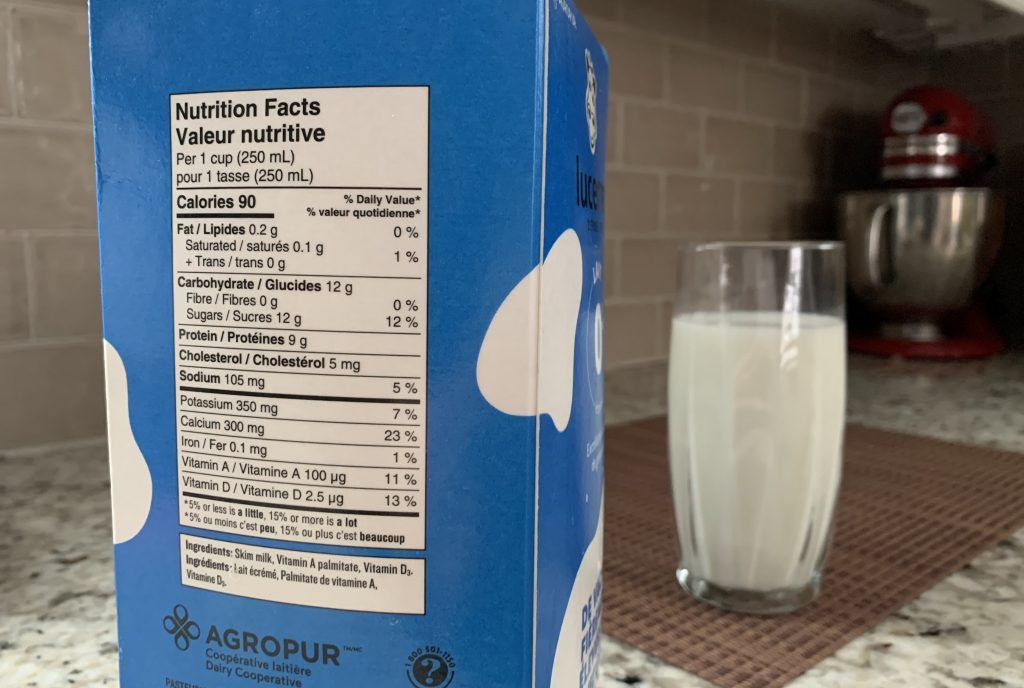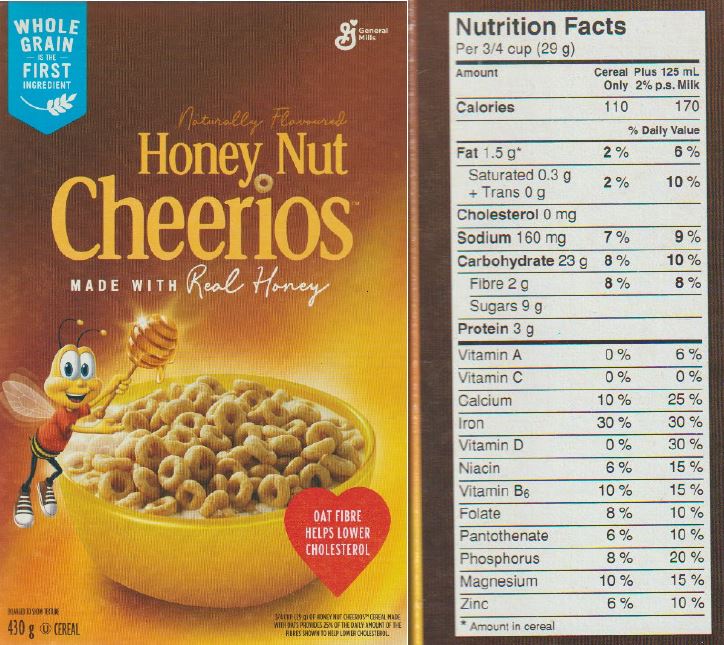
Choosing healthy foods is much easier when you learn to understand food labels. Food labels contain valuable information like ingredients, nutrition information, and best before dates. Some food labels also have food marketing information and health claims. It is important to learn how to read these labels to be a wise shopper and to know exactly what you are buying.
Nutrition Information
Nutrition information is helpful in choosing the right product for you and your family. Nutrition information is presented in a standard Nutrition Facts table on food packaging.
A nutrition facts table is the rectangle box located on either the side or back of a food package. It lists nutrients, percentages and weights particular to a food item. If you are trying to improve healthy eating habits or have specific diet needs/goals like lower fat, reduce sugar, and lower cholesterol, nutrition fact tables will help in choosing foods that are healthy for you.
Information on the Nutrition Facts Table
- Serving Size This value is located at the top of the nutrition facts table, just under the title. Values are normally listed in cups, grams or by the piece. This value is important when comparing food items (to make sure you are comparing equal amounts) and also in understanding the amount of nutrients in one serving.
Example: Honey Nut Cheerios
The serving size listed in this example is ¾ cup of cereal, or 28 grams. The quantities listed in the Nutrition facts table are for ONE serving.

It is common to eat more than one serving and not be aware of it. If you are eating more than the suggested serving size, for example a bowl with 1 ½ cups of cereal, the amounts listed on the box would have to be doubled in order to determine the amount of calories and nutrients (i.e. protein, fat, sugar, etc.) consumed.
- Energy/Calories The energy content in food is the calories. Every food and drink that contain carbohydrates, fat or protein contains calories, and this is what gives you energy every day.
- Nutrients In Canada, 13 core nutrients must be listed on food products. These include: fat, saturated fat, trans fat, cholesterol, sodium, carbohydrate, fibre, sugars, protein, vitamin A, vitamin C, calcium, and iron. There are additional nutrients which may also be included but are not mandatory.
Healthy eating suggestions include:- More vitamins, minerals, protein and fibre
- Less salt, sugar and fat (including saturated and trans fats)
Healthy eating tip: By comparing brands and varieties using the nutrition facts table, you will be able to choose a product that best fits your health needs. Most commonly, consumers watch for levels of sodium, sugar, fat and cholesterol.
When selecting a cereal, the ideal nutrient profile would be one that has at least 4 grams of protein; 4 grams of fibre and less than or equal to 8 grams of sugar. Why higher protein and fibre and less sugar? When protein and fibre are consumed, nutrients are slowly released into the bloodstream providing longer lasting energy throughout the day.
- Percent Daily Value (%DV) The percent daily value informs consumers if nutrients are high or low in a food product. These values are found on the right-hand side of the nutrition facts table.
- When %Daily Value is 15% or more, a lot of a nutrient is present
- When %Daily Value is 5% or less, a little of a nutrient is present
Do all food items sold at the grocery store have nutrition facts tables? Fresh foods such as vegetables, fruit, meat, fish and seafood do not require a nutrition facts table attached to the packaging. In addition, bakery goods and salads which are made in-store do not require nutrition information. Other exceptions include food sold at fairs or farmer markets and food that contain very few nutrients like vinegar, coffee and tea.
For reference, print the Reading the Nutrition Facts Table information sheet.
Ingredient List
Packaged food products include a list of ingredients used in making the food. Ingredients are listed in order of weight with the most abundant ingredient appearing first, and the ingredient in the smallest amount being last on the list.
Healthy eating tip: avoid buying foods that list sugar in the top 5 ingredients.
Best Before Dates
Best before dates are required on foods with a shelf life of 90 days or less. The date on the package indicates the time limit during which a product, if properly stored, will stay fresh. Food is still edible after the best before date has passed. Best before dates are only an indicator of food quality, not food safety. Best before dates only apply to unopened foods, as once the package is opened the shelf life will change. Always refer to directions on the package for the best food storage instructions.
If you are eating food that is past the best before date, look for signs of rot or smell to evaluate food quality first. Remember that harmful bacteria can grow in in foods and potentially cause food poisoning, even if a food does not appear to be rotten. Never eat any food if you are unsure of it’s safety.
To learn more about how to read best before dates, read Health Canada’s article How to read food date labels and packaging.
Other Information on Labels
Previously Frozen
‘Previously Frozen’ stickers may be found on meat. Meats that are marked with a previously frozen sticker on the package should only be purchased if they can be used up right away or cooked before they are frozen again.
Do not refreeze previously frozen foods without cooking first. This is a food safety consideration.
Country of Origin
All food sold in Canada, no matter where it is produced, must meet the same food safety standards. Food that is made outside of Canada must be marked as imported. If you are looking for product that is Canadian produced, look for ‘Product of Canada’ or ‘Made in Canada’ on the label. The rules about this labelling can be found in the article Shopping for Canadian Food by the Canadian Food Inspection Agency.
Grades
Many food products have been graded. This means they have been rated according to government standards. Grading is a measure of quality (colour, appearance, uniform size, etc.) and not a measure of nutritional value. Often there are savings to be found at the grocery store by purchasing “imperfect” vegetables and fruit that do not meet consistent size or colour standards. When purchasing canned fruits and vegetables, there are three possible grades: Canada Fancy, Canada Choice or Canada Standard. Frozen produce is either Canada A, B or C. All food grades give the same nutritional value, but Canada Fancy may have a better colour and be of a more uniform size than Canada Choice. If you are serving a vegetable as a side dish, the canned Canada Fancy or frozen Canada A might be preferred, however the often less expensive Canada Choice/Standard or Canada B/C would be perfectly suited to making a casserole or soup.
To learn more about food labelling, read the following articles:
Understanding Food Labels in Canada by the Dietitians of Canada
Using Food Labels by Canada’s Food Guide
Read these articles next:
Reduce Food Waste at Home
Healthy Eating Habits






